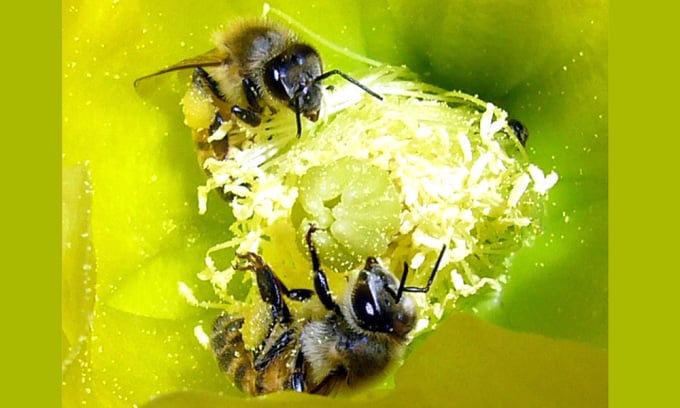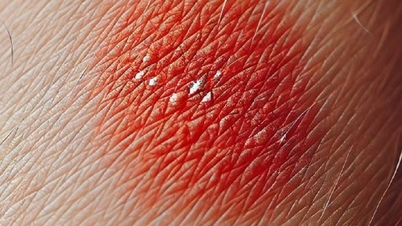A 60-year-old man suffered 250 stings, most likely from killer bees known for their aggression and tendency to sting in swarms.

Killer bees ( Africanized bees) collect pollen in the Mojave Desert. Photo: Wikimedia
John Fischer, a 60-year-old man from Arizona, was out with his dog when a swarm of bees attacked him. Fischer was in a wheelchair and the vehicle flipped over, leaving him unable to escape. At the hospital, doctors found more than 250 bee stingers in Fischer's body. He has since been discharged and is recovering, Live Science reported on May 31.
Reports suggest that killer bees, also known as Africanized bees, are to blame. Killer bees were first bred by a Brazilian scientist who was trying to combine the European honeybee's massive honey production with the Africanized honeybee's adaptation to warmer climates, according to the Natural History Museum in London.
A recent study in the journal Clinical Case Reports estimated that 50 to 500 bee stings at once are enough to kill an adult. However, the USDA estimates a higher number, around 1,100 for adults and 500 for children, based on the assumption that the average person can withstand 10 stings per pound of body weight. Based on these figures, Fischer had about 250 stings, so he may still be below the fatality threshold.

John Fischer, who suffered more than 250 bee stings. Photo: KTVK/KPHO
Fischer is not the first person to survive this danger. In 2014, a Texas worker was stung by about 1,000 killer bees and survived. That same year, a 71-year-old woman was attacked by a swarm of 80,000 killer bees and survived about 1,000 stings.
Some people, however, cannot survive similar attacks. For example, a 23-year-old hiker died from 1,000 stings in 2016 in Arizona.
For people allergic to bee stings, the immune system's reaction to the sting can be severe and affect the entire body, leading to anaphylaxis and death. Several studies have shown that body weight, immune status, and age affect how a person reacts to a bee sting. According to Boston Children's Hospital, people with bee sting allergies over the age of 25 are more likely to go into anaphylactic shock after a sting, in part because allergic reactions to bee venom can get worse cumulatively (the victim experiences more stings).
Common non-allergic reactions to bee stings include pain, swelling, and redness in the affected area. Allergic reactions can include hives, nausea, dizziness, abdominal pain, vomiting, diarrhea, low blood pressure, and swelling in areas that were not stung, according to the USDA. Seattle Children's Hospital says the main signs of anaphylaxis are hives along with difficulty breathing and swallowing.
Killer bees, also known as Africanized bees, migrate north from Brazil, through South and Central America, and into the United States. Over the years, their aggressive behavior and tendency to swarm and sting in groups have earned them the reputation of being “killer bees.” But contrary to popular belief, their venom is no more potent than that of the European honeybee.
In some cases, a single sting can be fatal. In 2009, Ray Shaw, former chairman of Dow Jones, died after being stung by an unidentified bee in his garage. However, single stings from bees, including killer bees, are rarely fatal.
Each year, about 3% of people who are stung by insects experience anaphylaxis—a severe, potentially life-threatening reaction. Anaphylaxis can occur in people who know they are allergic to bee stings, as well as those who are not. According to a 2019 report from the Centers for Disease Control and Prevention (CDC), there were an average of 62 deaths each year from wasp, hornet, and bee stings in the United States between 2000 and 2017. According to a recent YouGov poll, as many as 75% of Americans have been stung by a bee. As a result, fatal bee stings are rare.
Thu Thao (According to Live Science )
Source link



![[Photo] Prime Minister Pham Minh Chinh chairs meeting on science and technology development](https://vphoto.vietnam.vn/thumb/1200x675/vietnam/resource/IMAGE/2025/5/17/ae80dd74c384439789b12013c738a045)
![[Photo] More than 17,000 candidates participate in the 2025 SPT Competency Assessment Test of Hanoi National University of Education](https://vphoto.vietnam.vn/thumb/1200x675/vietnam/resource/IMAGE/2025/5/17/e538d9a1636c407cbb211b314e6303fd)
![[Photo] Readers line up to visit the photo exhibition and receive a special publication commemorating the 135th birthday of President Ho Chi Minh at Nhan Dan Newspaper](https://vphoto.vietnam.vn/thumb/1200x675/vietnam/resource/IMAGE/2025/5/17/85b3197fc6bd43e6a9ee4db15101005b)





























![[Photo] Nearly 3,000 students moved by stories about soldiers](https://vphoto.vietnam.vn/thumb/1200x675/vietnam/resource/IMAGE/2025/5/17/21da57c8241e42438b423eaa37215e0e)








































































Comment (0)